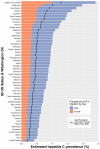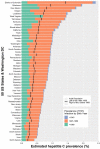Hepatitis C Virus Prevalence in 50 U.S. States and D.C. by Sex, Birth Cohort, and Race: 2013-2016
- PMID: 32140654
- PMCID: PMC7049678
- DOI: 10.1002/hep4.1457
Hepatitis C Virus Prevalence in 50 U.S. States and D.C. by Sex, Birth Cohort, and Race: 2013-2016
Abstract
Hepatitis C virus (HCV) infection is a leading cause of liver-related morbidity and mortality, and more than 2 million adults in the United States are estimated to be currently infected. Reducing HCV burden will require an understanding of demographic disparities and targeted efforts to reduce prevalence in populations with disproportionate disease rates. We modeled state-level estimates of hepatitis C prevalence among U.S. adults by sex, birth cohort, and race during 2013-2016. National Health and Nutrition Examination Survey data were used in combination with state-level HCV-related and narcotic overdose-related mortality data from the National Vital Statistics System and estimates from external literature review on populations not sampled in the National Health and Nutrition Examination Survey. Nationally, estimated hepatitis C prevalence was 1.3% among males and 0.6% among females (prevalence ratio [PR] = 2.3). Among persons born during 1945 to 1969, prevalence was 1.6% compared with 0.5% among persons born after 1969 (PR = 3.2). Among persons born during 1945 to 1969, prevalence ranged from 0.7% in North Dakota to 3.6% in Oklahoma and 6.8% in the District of Columbia. Among persons born after 1969, prevalence was more than twice as high in Kentucky, New Mexico, Oklahoma, and West Virginia compared with the national average. Hepatitis C prevalence was 1.8% among non-Hispanic black persons and 0.8% among persons of other races (PR = 2.2), and the magnitude of this disparity varied widely across jurisdictions (PR range: 1.3-7.8). Overall, 23% of prevalent HCV infections occurred among non-Hispanic black persons, whereas 12% of the population was represented by this racial group. These estimates provide information on prevalent HCV infections that jurisdictions can use for understanding and monitoring local disease patterns and racial disparities in burden of disease.
© 2019 The Authors. Hepatology Communications published by Wiley Periodicals, Inc., on behalf of the American Association for the Study of Liver Diseases.
Figures




Similar articles
-
Estimates of state-level chronic hepatitis C virus infection, stratified by race and sex, United States, 2010.BMC Infect Dis. 2018 May 16;18(1):224. doi: 10.1186/s12879-018-3133-6. BMC Infect Dis. 2018. PMID: 29769036 Free PMC article.
-
Prevalence of Hepatitis C Virus Infection in US States and the District of Columbia, 2013 to 2016.JAMA Netw Open. 2018 Dec 7;1(8):e186371. doi: 10.1001/jamanetworkopen.2018.6371. JAMA Netw Open. 2018. PMID: 30646319 Free PMC article.
-
Surveillance for Violent Deaths - National Violent Death Reporting System, 42 States, the District of Columbia, and Puerto Rico, 2019.MMWR Surveill Summ. 2022 May 20;71(6):1-40. doi: 10.15585/mmwr.ss7106a1. MMWR Surveill Summ. 2022. PMID: 35588398 Free PMC article.
-
The burden of hepatitis C in the United States.Hepatology. 2002 Nov;36(5 Suppl 1):S30-4. doi: 10.1053/jhep.2002.36791. Hepatology. 2002. PMID: 12407574 Review.
-
Appendix: The National Institutes of Health Consensus Development Conference Management of Hepatitis C 2002.Clin Liver Dis. 2003 Feb;7(1):261-87. doi: 10.1016/s1089-3261(02)00078-8. Clin Liver Dis. 2003. PMID: 12691470 Review.
Cited by
-
Donor hepatitis C status is not associated with an increased risk of acute rejection in kidney transplantation.Surg Pract Sci. 2024 Feb 6;16:100236. doi: 10.1016/j.sipas.2024.100236. eCollection 2024 Mar. Surg Pract Sci. 2024. PMID: 39845340 Free PMC article.
-
Trends in Hepatitis C Virus and HIV Care Outcomes Among People With HIV in Georgia, United States, 2014-2019.Public Health Rep. 2024 Jul-Aug;139(4):476-483. doi: 10.1177/00333549231205341. Epub 2023 Nov 4. Public Health Rep. 2024. PMID: 37924243 Free PMC article.
-
Epidemiology and Clinical Characteristics of Individuals with Hepatitis C Virus Infection in the United States, 2017-2019.Adv Ther. 2021 Dec;38(12):5777-5790. doi: 10.1007/s12325-021-01928-y. Epub 2021 Oct 27. Adv Ther. 2021. PMID: 34704194 Free PMC article.
-
Hepatitis C Virus-HIV Coinfection in the United States Among People Who Inject Drugs: Data Needed for Ending Dual Epidemics.Public Health Rep. 2023 Jul 22:333549231181348. doi: 10.1177/00333549231181348. Online ahead of print. Public Health Rep. 2023. PMID: 37480274 Free PMC article. Review.
-
What Hepatitis C Virus (HCV) Diagnostic Tools Are Needed to Advance Diagnosis of Current HCV Infection in Outreach Settings and in a Nonclinical Setting?J Infect Dis. 2024 May 8;229(Supplement_3):S328-S333. doi: 10.1093/infdis/jiad269. J Infect Dis. 2024. PMID: 37739782 Free PMC article.
References
-
- Centers for Disease Control and Prevention . Surveillance for Viral Hepatitis—United States, 2016. Updated 2017. https://www.cdc.gov/hepatitis/statistics/2016surveillance/commentary.htm. Accessed January 1, 2018.
-
- Chhatwal J, Chen Q, Aggarwal R. Estimation of hepatitis C disease burden and budget impact of treatment using health economic modeling. Infect Dis Clin North Am 2018;32:461‐480. - PubMed
-
- Smith BD, Morgan RL, Beckett GA, Falck‐Ytter Y, Holtzman D, Teo CG, et al. Recommendations for the identification of chronic hepatitis C virus infection among persons born during 1945‐1965. MMWR Recomm Rep 2012;61:1‐32. - PubMed
Grants and funding
LinkOut - more resources
Full Text Sources
Research Materials

